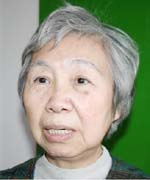"Hiroshima, Children's Summer" by Keiko Murakami

|
The book is made up of three short stories: "Boku Kabeshimbun wo tsukurunda" ("Making a Wall Newspaper") in which a boy listens to the story of a woman who cared for atomic bomb survivors [a "wall newspaper" is like the front page of a newspaper and it is posted on the wall]; "Sayonara sankaku" ("Goodbye, Triangle") which deals with the issue of different family names for a married couple from the viewpoints of two contrasting families; and "Akai me no chibi" ("The Little One with Red Eyes") which looks at coexistence with the weak from the perspective of a pet hamster. |
People other than survivors speak out about peace
Make an effort to blur national borders

|
Keiko Murakami
Born in Naka Ward, Hiroshima in 1937. She graduated from Hiroshima Women's Collage (now, the Prefectural University of Hiroshima). In 1981, she won first prize for her submission in a literature contest for citizens of Hiroshima. In 2002, she left Hiroshima and moved to Ibaraki Prefecture, where her daughter lives.
A book for children titled "Hiroshima, Children's Summer" contains three stories, including "Making a Wall Newspaper," which focus on the atomic bombing of Hiroshima. The book was written by Keiko Murakami, 74, who experienced the atomic bombing when she was 8 years old. In the book she expresses her hope that "children grow up to be adults who take action to build peace."
The story "Making a Wall Newspaper" offers the real account of a woman who provided aid to A-bomb survivors on Ninoshima Island in Hiroshima Bay. In the aftermath of the bombing, many of the wounded were brought to Ninoshima by boat. The woman spoke to the people who were dying, asking their names and listening to their final thoughts. Ms. Murakami was so impressed with the woman's words--"When so many were dying in the streets, we can at least find some value in the fact that we took down names to record who they were"--she decided to write the story.
Another story, "Goodbye, Triangle," tells the tale of a woman who moves to Hiroshima to become a guide and convey the atomic bombing to international visitors. Through the story, Mr. Murakami hopes people will feel that "It isn't only the A-bomb survivors who should speak out about Hiroshima's experience; others should now take over conveying the reality of the atomic bombing from the aging survivors." The story expresses her wish that people who didn't experience the bombing will be proactive in talking about the importance of peace.
When the atomic bomb was dropped on August 6, 1945, Ms. Murakami was at home with her parents and her younger brother and sister in Hakushima, about 1.7 kilometers from the hypocenter. Her father, feeling alarmed at the sound of planes overhead, shouted for the family to hurry into the air raid shelter. Ms. Murakami escaped into the shelter with her younger brother, but her father did not reach the shelter in time and was severely injured. Her mother, still in the house, was blinded in one eye by flying fragments of glass.
Although she now shares her account of the bombing in Japan and countries overseas, for a long time she wasn't able to speak about that harrowing time. She wrote the book in the years 1988 to 1990, but the stories weren't based on her own experience. However, around 1995, when she served as a guide for a German priest in Hiroshima, he told her that, during World War II, his friend suddenly disappeared. Later, he learned that his friend was a Jew. Recalling the genocide of the Jews, she realized that only people who lived through a certain time can speak intimately about it. And so she began speaking about her experience of the atomic bombing.
When she shares her experience of the bombing at schools, she displays a white map that has no national borders. "Originally, there weren't any national borders," she explained. "The borders were drawn over the years by many people. Once they were made, though, they became hard to erase. I would like us to blur those borders."
Ms. Murakami offered advice to young people today, saying, "Visit as many other countries as you can and make a lot of friends." She believes that friendship can lead to "the people of the world loving one another and forgiving one another."
|